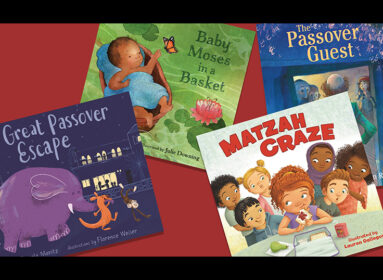By Judy Lash Balint/JNS.org

A volunteer at last year’s Meir Panim Purim celebration in Israel. Once it raises the necessary funds, Meir Panim is planning a $12 million nutrition center in the southern Israeli town of Kiryat Gat. The current After School Youth Clubs of Meir Panim, meanwhile, reach thousands of at-risk youths.
Credit: Courtesy Meir Panim.
Israelis take Purim seriously—kids get the day off school, many towns put on a lively Purim parade, and the streets are filled with people of all ages running about in costumes, delivering mishloach manot baskets of prepared food goodies to their friends and neighbors before sitting down to the seuda, a festive meal that includes plenty of spirits.
But all these items add up, and Purim can be a costly event. For the one third of all Israeli children who live in poverty, Purim wouldn’t be Purim without the help of an array of non-profit organizations who take the holiday’s other mitzvah to heart.
According to Maimonides, the great medieval Jewish scholar, “Gifts for the poor (matanot l’evyonim) deserve more attention than the seuda and mishloach manot because there is no greater, richer happiness than bringing joy to the hearts of needy people, orphans, widows and proselytes.”
Despite Israel’s image as the hi-tech “start-up nation,” there are plenty of needy people in the Jewish state. In 2012, according to Israel’s National Insurance Institute, there were 1.75 million poor people in Israel (out of a total population of just more than 8 million), among them some 817,000 children.
Many organizations that are set up to help the poor are run by Torah observant Israelis, and at Purim, they go into high gear to fulfill the precept of Maimonides.
Rabbi Yakov Schischa, founder and director of the Tov V’Chesed (tovvchesed.com) Foundation based in Jerusalem’s Meah Shearim neighborhood, explains how his group not only prepares and delivers hundreds of mishloach manot Purim baskets packed with prepared foods, sweets, wine, and toys, but also sends out teams of volunteers who visit single-parent families to spend time bringing Purim joy into homes that may be short on simcha (happiness). A large number of the families also receive a gift of cash in honor of Purim, “but we know it will actually get used to prepare for Passover,” Schischa notes. His organization serves some 2,500 families per year.

A woman dressed up in a costume for the Jewish holiday of Purim walks by a homeless man sleeping outside the Mashbir mall in the center of Jerusalem on March 7, 2012. Many Israeli organizations that are set up to help the poor go into high gear on Purim, to fulfill that holiday’s mitzvah of gifts for the poor, in Hebrew “matanot l’evyonim.”
Credit: Nati Shohat/Flash90.
The motto of Yad Ezra V’Shulamit (yadezra.net), another group founded by someone with first-hand knowledge of growing up poor, is “Breaking the Cycle of Poverty One Child at a Time.” “The families we reach are in very deep poverty,” says spokesperson Meira Brandwein. “They’re not just people who have fallen on hard times. These are people who need immediate relief. Yad Ezra V’Shulamit serves more than 1,000 children every day with hot meals as well as tutoring and social programs; clubs for teens at risk; food baskets filled with healthy food for 2,800 families per week; vocational counseling for the unemployed; and financial assistance to help with bar/bat mitzvah and wedding celebrations, winter clothes, and school supplies that are beyond the budget of those at the bottom of Israel’s economic ladder.
For Purim, matanot l’evyonim donations to Yad Ezra V’Shulamit are added to the funds that come from a mix of private Israeli and foreign donors, U.S Jewish Federations and in-kind contributions from Israeli businesses, to provide needy families with items to enable them to feel part of the holiday.
At the seven restaurants run by Meir Panim (meirpanim.org) , a network of nutrition-related programs for the poor, Purim is a time for increased efforts to bring relief to thousands in need. “Meir Panim means lighting up faces,” explains assistant director Goldie Sternbuch. “We do it all year around, but especially at Purim.” The restaurants provide what Sternbuch calls “a dignified approach to feeding the poor.” But needs are burgeoning and while food is an urgent issue, it is only one component of a holistic approach to help get people “back in the mainstream.”
One target group for mainstreaming is teenagers from disadvantaged families. The After School Youth Clubs of Meir Panim reach thousands of at-risk youths, who get motivated by energetic young volunteers and professional counselors to stay in school and continue their education.
As soon as the final chunk of money is raised, Meir Panim will launch its most ambitious project to date—a $12 million Israel Nutrition Center located in the southern town of Kiryat Gat and named for well-known U.S. philanthropist Mortimer Zuckerman and his daughter Abigail. The facility will be the largest food distribution center in the Middle East, set to serve 30,000 meals every day to disadvantaged school kids, the free restaurants and meals on wheels programs around the country. It is a massive undertaking that will be managed in partnership with a large Israeli catering company.
Rabbi Schischa of Tov V’Chesed acknowledges that programs like his “can’t fix the world,” but “at Purim, everyone can take part in the mitzvah of matanot l’evyonim to bring more joy into the world.”
Hold the jam: Creative Hamantaschen from ‘Queen of Kosher’ Jamie Geller
By JNS.org
We all recognize that poppy seed or jam taste when we bite into hamantaschen on Purim every year. But given the right filling, or dough, the traditional pastry has a lot more to offer.
Hailed as the “Queen of Kosher” and the “Jewish Rachael Ray,” best-selling author Jamie Geller is the founder of the Kosher Media Network, publisher of Joy of Kosher with Jamie Geller magazine and JoyofKosher.com. Geller’s online cooking videos have garnered over 1 million views.
The following recipes, edited by JNS.org, were recommended by Geller and have appeared on JoyofKosher.com and in Joy of Kosher with Jamie Geller magazine. The stuffed Hamantaschen challah recipe is based on Geller’s own challah recipe, as it appeared in her cookbook Joy of Kosher: Fast, Fresh Family Recipes (William Morrow/Harper Collins).

Cardamom scented hamantaschen with pear and goat cheese filling.
Credit: “JOY OF KOSHER: Fast, Fresh Family Recipes by Jamie Geller.”
Cardamom Scented Hamantaschen with Pear & Goat Cheese Filling
By Pessy Haskelevich, writer for Joy of Kosher with Jamie Geller magazine
For a pareve version, simply replace the butter with canola oil and omit the goat cheese.
Prep Time: 40 minutes
Servings: 2 dozen
Ingredients:
For the Pastry:
2 eggs
1/2 cup sugar
1/2 stick butter, or 1/4 cup canola oil
Juice and zest of 1 lemon
1/2 teaspoon vanilla extract
2 1/2 cups flour
1 teaspoon baking powder
1-2 teaspoons cardamom or hawayij
Pinch of salt
For the filling:
1/2 cup water
1/8 cup sugar
Juice of 1 lemon
1 tablespoon fresh ginger, peeled and minced
1 lb firm but ripe pears, peeled, cored and cut into 1/4 inch diced pieces
3/4 cup apricot jam
1/2 cup chopped walnuts
8 oz soft goat cheese (optional)
Directions:
Preparing the pastry:
1. In a mixing bowl, beat the eggs and sugar until light and fluffy.
2. Add the rest of the ingredients and mix well.
3. Divide the dough in half and chill in plastic wrap for half an hour.
Preparing the filling:
1. Combine the water and sugar in a medium saucepan and simmer over low heat until sugar has dissolved.
2. Add the lemon juice, ginger and pears and simmer for an additional 10 minutes, or until pears are tender. Set aside to cool.
To assemble and bake:
1. On a generously floured surface, preferably on baking paper, roll out the dough to a quarter-inch thickness. Roll once, then pick up the flattened dough and turn it 90 degrees. Sprinkle with more flour if necessary and roll it out again. Repeat until dough is of sufficient thickness (this procedure helps prevent the dough from sticking). Use a round cookie cutter or glass with a 2-3 inch diameter to cut out circles of dough.
2. Smear a very thin layer of apricot preserves in the center of each circle.
3. Sprinkle 1/2 teaspoon walnuts and a small piece of crumbled goat cheese.
4. Top with 1 teaspoon of pear jam.
5. Lift up the edges of the circle to form a triangle. Pinch the corners securely so that they don’t open in the oven.
6. Line a cookie sheet with baking paper and place the assembled hamantaschen on the cookie sheet. Chill the hamantaschen in the freezer for about half an hour.
7. Repeat with second half of dough.
8. Bake the hamantaschen in the oven at 375° F for 20-24 minutes or until golden. Cool on rack.

Gingerbread hamantaschen with spiced apple filling.
Credit: “JOY OF KOSHER: Fast, Fresh Family Recipes by Jamie Geller.”
Gingerbread Hamantaschen with Spiced Apple Filling
By Tamar Genger, executive editor, JoyofKosher.com
Prep Time: 30 minutes
Cook Time: 10 minutes
Servings: 36
Ingredients:
For the cookie dough:
2 cups whole wheat flour
1 cup all purpose flour plus more for dusting
1 teaspoon baking soda
1/4 cup brown sugar, packed
3/4 teaspoon ground cinnamon
1 1/2 teaspoon ground ginger
1/2 teaspoon ground allspice
1/2 teaspoon ground cloves
1/2 teaspoon salt
1/4 teaspoon freshly milled black pepper
8 tablespoons (1 stick) unsalted margarine, room temperature
1/4 cup vegetable shortening, at room temperature
1/2 cup packed light brown sugar
2/3 cup unsulfured molasses
1 large egg
For the filling:
6 tablespoons margarine, cut in 1-inch pieces
1/2 vanilla bean, cut lengthwise and scraped of seeds
3 large or 4 medium apples, peeled, cored and cut into eighths
1/4 cup brown sugar, packed
Directions:
Gingerbread cookie dough:
1. Sift the flours, baking soda, cinnamon, ginger, allspice, cloves, salt and pepper through a wire sieve into a medium bowl. Set aside.
2. In a stand mixer, beat the margarine and shortening on high until well blended, about 1 minute. Add the brown sugar and beat until the mixture is light in texture and color, about 2 minutes. Beat in the molasses and egg. Using a wooden spoon, gradually mix in the flour mixture to make a stiff dough. Divide the dough into two thick disks and wrap each disk in plastic wrap. Refrigerate until chilled, about 3 hours. (The dough can be prepared up to 2 days ahead.)
Filling:
1. In a large skillet over medium heat add the margarine and vanilla bean and seeds, cook about 5 minutes. Add the apples and let them caramelize on one side, then turn and cook until it beings to caramelize. Sprinkle the brown sugar over the apples and cook turning occasionally while it softens about 10 minutes. Remove from heat and remove vanilla bean, then puree in food processor and cool until ready to use.
2. When ready to assemble and bake the cookies, position the racks in the top and bottom thirds of the oven and preheat to 350° F.
3. To roll out the cookies, work with one disk at a time, keeping the other disk refrigerated. Remove the dough from the refrigerator and let stand at room temperature until just warm enough to roll out without cracking, about 10 minutes. (If the dough has been chilled for longer than 3 hours, it may need a few more minutes.) Place the dough on a lightly floured work surface and sprinkle the top of the dough with flour. Roll out the dough 1/8 inch thick. Cut out 3-inch circles and use a spatula to place circles on a baking sheet lined with parchment.
4. Spoon a teaspoon of filling into the center of the circle of dough and fold together to form a triangle. Bake for 8-10 minutes, remove to wire rack to cool, and enjoy.
Purim Calendar of Events
Saturday, March 15
Bridgeport – An Evening of (Adult) Comedy with Joel Chasnoff; Purim spiel; Middle Eastern dinner with wine, beer, dessert and coffee; 6:30 p.m.; Congregation B’nai Israel, 2710 Park Ave., lynn@cbibpt.org. Reserve your seat today! $54. Reservations a must.
Fairfield – Beth El and Rodeph Sholom Joint Purim Celebration, dinner at 6:30 p.m. followed by Purim Shpiel/Play, 7:30: dessert followed by costume parade; 7:45 p.m.: havdallah service; 8 p.m.: megillah reading, at Cong. Beth El, 1200 Fairfield Woods Road, RSVP for dinner only: (203) 374-5544 or congbethel@aol.com. $18/adults; $10/child.
Greenwich – Hamantaschen, Costumes & Birthdays at Temple Shalom; come in your Purim costume, dancing, singing and hamentaschen, 5:30-6 p.m., 300 E. Putnam Ave., (203) 542-7165.
Greenwich – Family Hamantaschen Bake and Dinner; bake hamantaschen and enjoy a pizza, 6 p.m., followed by megillah reading. Temple Sholom, 300 E. Putnam Ave., (203) 542-7161. $5/person; $20/family max.
Greenwich – Pleasantville, N.Y. – Red Carpet Glamour for You and Me, Purim Fun at Shir Ami, 7:30 p.m., 10 Trapping Way, Pleasantville, N.Y., (203) 274-5376.
Meriden – Reading of Megillah; prizes awarded for costumes in various caregories; with refreshments; 7:30 p.m., Temple B’nai Abraham, 127 East Main St., (203) 235-2581.
Norwalk – Mardi Gras In Shushan: A New Orleans Purim Concert, followed by costume parade, mini-carnival and food, 7:45 p.m., Cong. Beth El, 109 East Ave., (203) 838-2710.
Norwalk – Young Jewish Professionals CT (20’s and 30’s) Black & White Purim Party, 8:30-11 p.m., Episode Ultra Lounge, 112 Washington St., SoNo, RSVP: (203) 635-4118 or youngjewishp@gmail.com. $20/person
Orange – Purim in Hollywood, with megillah reading, Nu Haven Kapelye Klezmer Orchestra, red carpet photo shoot, Chinese food and salad bar; for adults and teens over 16, 8:15 p.m., Chabad of Orange/Woodbridge, 261 Derby Ave., RSVP: (203) 795-7095. $20/person; $18 by March 11.
West Hartford –Purim Party follows the reading of the Megillah at 8:30 p.m.; music by local rock band, Vinyl Tap; refreshments; Beth El Temple, 2626 Albany Ave., (860) 233-9696. FREE
Westport – Purim at Beit Chaverim Synagogue, 8 p.m., 85 Post Road.
Sunday, March 16
Danbury – Chabad of Ridgefield Royal Purim Feast, noon, Crown Plaza Danbury, 18 Old Ridgebury Road, chabadridgefield.com. $1/adults; $15/child
Fairfield – Purim Feast in the Shtetl, 4:30 p.m., Chabad of Fairfield, 1571 Stratfield Road, (203) 373-7551.$12/child; $18/adults; $75/family max.
Fairfield – Beth El and Rodeph Sholom Joint Purim Celebration, 8:30 a.m.: morning minyan; 9:30 a.m.: Teen program, “Learn How to be a Clown”, 10:30 a.m.: Kid’s Purim Sing-a-Long for Hebrew school-aged kids; 11 a.m. – 1 p.m.: Purim Carnival; at Rodeph Sholom, 2385 Park Ave., (203) 334-0159. $10/per child; $25/maximum family.
Georgetown – Purimpalooza, 10 a.m. – 1 p.m., Temple B’nai Chaim, 82 Portland Ave., (203) 544-8695.
Greenwich – Purim in the Palace; megillah reading, hamantaschen, carnival; 10:30 a.m. megillah reading, 11 a.m. carnival; hosted by Chabad of Greenwich at the Greenwich YMCA, 50 East Putnam Ave., (203) 629-9059. $30/adult; $25/children; $90/family.
Greenwich – Purim Carnival, PJ Library activities for preschoolers; costume pageant and prizes for all children who participate, 11 a.m. – 1 p.m., Temple Sholom, 300 E. Putnam Ave., (203) 542-7161. $20/child; $40/2 or more children.
New Canaan – Purim in Israel, presented by Chabad of New Canaan, 10:30 a.m., New Canaan Nature Center, 144 Oenoke Ridge, (203) 972-7708.
Norwalk – Purim Carnival, noon, Temple Shalom, 259 Richards Ave., admin@templeshalomweb.org or (203) 866-0148.
Norwalk – Purim Carnival following services, 10:30 a.m. – 1:30 p.m., games, rides and bouncy house, Cong. Beth El, 109 East Ave., (203) 838-2710. $10
Orange – Purim Palooza, megillah reading, masquerade party, lunch, player from Court Jesters Comedy basketball, Bobby Doowah; and Eric Girardi’s “Bending Gravity Performance,” 11 a.m. – 2 p.m., Chabad of Orange/Woodbridge, 261 Derby Ave., (203) 795-7095. $10/person; $8/children under 6.
Trumbull – Purim Carnival; dress in costume and get free game tickets; noon – 2 p.m.; Congregation B’nai Torah, 5700 Main St., (203) 268-6940, office@bnaitorahct.org.
West Hartford – Family Purim Celebration; dress in costume; entertainment by Musical IQ, with a drum and rhythm workshop; 4 – 6 p.m.; Mandell JCC, 335 Bloomfield Ave., (860) 236-4571.
West Hartford – Purim Play, with carnival to follow, featuring bounce house, games, prizes and food, 10:30 a.m., Congregation Beth Israel, 701 Farmington Ave., (860) 233-8215.$2/person, suggested donation.
West Hartford – Purim Under the Sea, with marine lab with live fish and marine animals, face-painting, carnival booths, costumes and sushi, 4:30 p.m., Hebrew High School of New England, 300 Bloomfield Ave.
West Hartford — “Superhero Purim Shpiel”; QueenEsther/Wonder Woman and Mordecai/Superman save the Jewish people; 11 a.m.; followed by a Purim carnival at 12 noon; Beth El Temple, 2626 Albany Ave., (860) 233-9696. FREE
Weston – Purim Extravaganza with Chinese buffet, sushi bar, megillah reading, singing and dancing, 3:30 p.m. (entertainment for children at 3:45 p.m.) Come in costume and receive a gift; Cobbs Mill Inn, 12 Old Mill Road, (203) 635-4118 or info@schneersoncenter.org.
Westport – Family Purim program of Cong. for Humanistic Judaism; with music, play reading by Sunday School students; carnival games and crafts, 11 a.m. – 2 p.m., Bedford Middle School, 88 North Ave., (203) 293-8867.
Westport – Masks and Crowns Annual Purim Carnival, 10 a.m. – 12:30 p.m., The Conservative Synagogue, 30 Hillspoint Road, (203) 454-4673.
Westport – Purim Schpiel, Megillah Reading and Carnival, 10:30 a.m., Temple Israel, 14 Coleytown Road, (203) 227-1293.
What is the name ‘Purim’ all about?
By Binyamin Kagedan/JNS.org
The names of religious holidays are usually fairly straightforward, pointing us to the central symbol or theme of the festival. But just what is the name “Purim” all about?

A painting of the triumph of Mordechai, who was paraded in royal clothing around the city of Shushan by Haman, an honor Haman had hoped he — not Mordechai — would receive upon suggesting the idea to King Ahasuerus.
Credit: Rembrandt House Museum via Wikimedia Commons.
Pur is an Assyrian word meaning “lot,” some object involved in a game or ritual of chance. The Megillah (or “Scroll”) of Esther uses the word pur to describe the method employed by Haman to choose the day on which the Jews of Susa (or Shushan) were to be massacred. For the benefit of its Hebrew-speaking audience, the megillah offers an on-the-spot translation: hipil pur hu hagoral, meaning “he cast pur, that is, lots,” goral being the common biblical term for a lottery. We can infer from this quick annotation that even ancient readers of the megillah would have been unfamiliar with the word pur.
What then do we know about Haman’s pur? In a fascinating article from 1983, biblical archaeologist William Hallo explains that the pur was nothing less than the oldest game in human history: dice. As the curator of the Yale Babylonian Collection, Hallo had under his care a clay cube dating back to the 9th century BCE, which belonged to a minister of the Assyrian king Salmaneser III.
A portion of the cuneiform text inscribed on the cube reads, “Iahali the grand vizier… in his year assigned to him by lot (pur) may the harvest of the land of Assyria prosper and thrive, in front of the gods Assur and Adad may his lot (pur) fall.” Here we see two striking similarities to the megilla text. Firstly, in both places the pur is used to make a decision about calendar time; secondly, both sport the verb “fall,” as in “Haman caused the pur to fall (hipil pur).”
How similar Haman’s use of the pur would have been to Iahali’s is still not clear. Scholars assume that the Scroll of Esther was written in the late Second Temple period, centuries later than Salmaneser III’s reign, and the practice of pur may have evolved and changed over time. There is still much more for archaeologists and biblical historians to uncover.








 Southern New England Jewish Ledger
Southern New England Jewish Ledger











